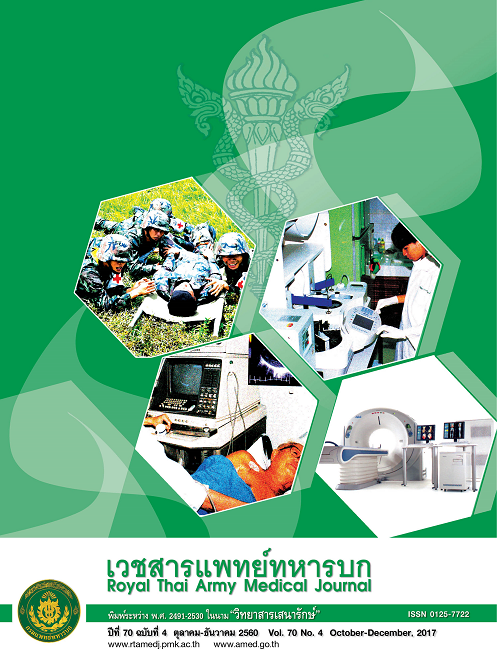การพัฒนาแบบวัดสภาวะแวดล้อมทางการศึกษาสำหรับนักเรียนแพทย์
Main Article Content
บทคัดย่อ
บทนำ สภาวะแวดล้อมทางการศึกษามีความสัมพันธ์ต่อผลสัมฤทธิ์ในการสอบเพื่อประเมินและรับรองความรู้ ความสามารถในการประกอบวิชาชีพเวชกรรมของนักเรียนแพทย์เป็นอย่างยิ่ง วัตถุประสงค์ เพื่อพัฒนาและตรวจสอบคุณภาพแบบวัดสภาวะแวดล้อมการศึกษา วิธีการ ตัวอย่างที่ใช้ในการศึกษา จำนวน 216 คน แบบวัดที่ถูกพัฒนาขึ้นประกอบด้วย 18 ข้อคำถาม แบ่งออกเป็น 5 ปัจจัยได้แก่ การรับรู้ด้านการเรียนการสอน การรับรู้ด้านอาจารย์ การรับรู้ด้านวิชาการด้วยตนเอง การรับรู้บรรยากาศทางวิชาการ และการรับรู้ด้านสังคมด้วยตนเอง ซึ่งผ่านการตรวจสอบความตรงตามเนื้อหาโดยอาศัยผู้เชี่ยวชาญจำนวน 3 คน จากนั้นคัดเลือกใช้ข้อคำถาม
ที่ผ่านเกณฑ์และตรวจสอบความตรงเชิงโครงสร้างของโมเดลการวัดสภาวะแวดล้อมการศึกษาโดยการวิเคราะห์องค์ประกอบเชิงยืนยันผลการวิจัย ทุกข้อคำถามของแบบวัดมีค่า IOC อยู่ระหว่าง 0.67-1.00 และค่าอำนาจจำแนกเป็นไปตามเกณฑ์ โดยมีค่าสัมประสิทธิ์แอลฟาของครอนบราค เท่ากับ 0.89 จากการวิเคราะห์องค์ประกอบเชิงยืนยัน พบว่า โมเดลภาพรวมที่มี 5 องค์ประกอบมีความสอดคล้องกลมกลืนกับข้อมูลเชิงประจักษ์ (Chi-square = 267.51 df = 125 p-value = 0.001 RMSEA = 0.073) เมื่อวิเคราะห์คุณภาพของแบบวัด โดยใช้ทฤษฎีการตอบสนองข้อสอบแบบตรวจให้คะแนนมากกว่า 2 ค่า ซึ่งใช้โมเดล graded-response model
(GRM) พบว่า มีค่า marginal reliability for response pattern scores เท่ากับ 0.90 ซึ่งถือว่ามีความเที่ยงสูง สรุป พบว่า แบบวัดสภาวะแวดล้อมทางการศึกษาที่ได้พัฒนาขึ้นมีคุณภาพของแบบวัดทั้งฉบับและรายข้อ สามารถนำไปใช้สำหรับวัดได้อย่างถูกต้องและเหมาะสม
A Development of Educational Environment Test for Medical Students
Introduction: The educational environment has effect to medical student. Objective: To develop and validate the educational environment test for medical student. Methods: Two hundred sixteen students were sampled. The developed test comprised of 18 questions divided into VI factors as follows; perception of learning, Perception of course organization, academic self-perception, perception of atmosphere and social self-perception. The content validity was determined by three experts to select the criterion-tested questionnaire and examine the
structural validity of the educational environment measure model. Results: All items had IOC values between 0.67-1.00, and discriminative power was in accordance with the criteria. The coefficient alpha of Cronbach’s is 0.89. Confirmatory factor analysis found that the five-factor of measure model was fit within empirical data (Chisquare = 267.51 df = 125 P-value = 0.001 RMSEA = 0.073). Item analysis by using graded-response model (GRM) was found that the high marginal reliability for response pattern scores. Conclusions: The developed educational
environment test has of high quality and can be used for accurate and appropriate measurements.
Downloads
Article Details
บทความในวารสารนี้อยู่ภายใต้ลิขสิทธิ์ของ กรมแพทย์ทหารบก และเผยแพร่ภายใต้สัญญาอนุญาต Creative Commons Attribution-NonCommercial-NoDerivatives 4.0 International (CC BY-NC-ND 4.0)
ท่านสามารถอ่านและใช้งานเพื่อวัตถุประสงค์ทางการศึกษา และทางวิชาการ เช่น การสอน การวิจัย หรือการอ้างอิง โดยต้องให้เครดิตอย่างเหมาะสมแก่ผู้เขียนและวารสาร
ห้ามใช้หรือแก้ไขบทความโดยไม่ได้รับอนุญาต
ข้อความที่ปรากฏในบทความเป็นความคิดเห็นของผู้เขียนเท่านั้น
ผู้เขียนเป็นผู้รับผิดชอบต่อเนื้อหาและความถูกต้องของบทความของตนอย่างเต็มที่
การนำบทความไปเผยแพร่ซ้ำในรูปแบบสาธารณะอื่นใด ต้องได้รับอนุญาตจากวารสาร


